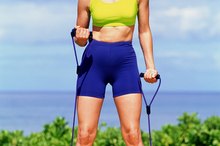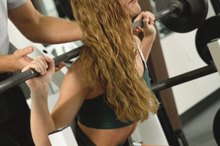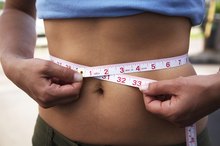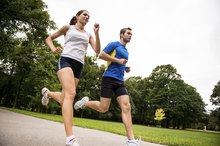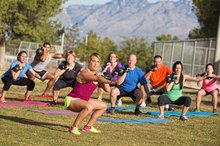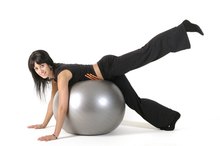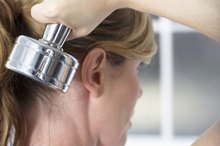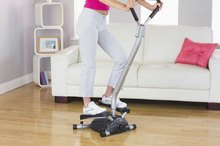Can Peanut Butter Make Your Butt Bigger?
The average American eats more than 6 lb. of peanuts and peanut butter per year, according to the American Peanut Council. Peanut butter can cause you to gain weight due to its calorie content, but it will not specifically increase the size of your butt. There are no foods that target particular parts of the body, but muscle-building exercise and overall changes in body composition due to diet and activity level can change the shape of your rear end to some degree.
Food Intake
To gain weight and therefore increase the size of your butt, it is necessary to take in more calories than you burn. A person with average body weight and a low activity level needs to eat 13 calories for every pound of body weight to maintain his weight, so eating more will cause a weight gain. A 2 tbsp. serving of peanut butter contains 14 grams of fat, 2.5 grams of saturated fat and 7 grams of protein, which makes it a quick and inexpensive way to add calories to your diet.
- To gain weight and therefore increase the size of your butt, it is necessary to take in more calories than you burn.
- A person with average body weight and a low activity level needs to eat 13 calories for every pound of body weight to maintain his weight, so eating more will cause a weight gain.
Calories Burned
How to Lose Arm Fat With Resistance Bands
Learn More
Burning fewer calories is another way to cause weight gain. The Centers for Disease Control recommends that the average adult get two and a half hours of moderately intense aerobic activity per week. Your exercise is moderate if it makes you sweat, increases your heart rate and leaves you with enough breath to talk but not sing. If you are exercising more intensely than that, you will burn more calories and therefore you need to take in more food.
- Burning fewer calories is another way to cause weight gain.
- Your exercise is moderate if it makes you sweat, increases your heart rate and leaves you with enough breath to talk but not sing.
Muscle Toning
Aside from gaining weight, the way to change the shape of your butt is to build the muscles in that area. Exercises that target your glutes include lunges and step-up exercises. For step-ups, stand behind an exercise step or sturdy step stool or at the bottom of a flight of stairs. Place one foot on the step and step up. Repeat, alternating feet. Lunges and step-ups can can be performed with just your body weight or you can do them while holding dumbbells in each hand to increase resistance.
- Aside from gaining weight, the way to change the shape of your butt is to build the muscles in that area.
- Lunges and step-ups can can be performed with just your body weight or you can do them while holding dumbbells in each hand to increase resistance.
Clothing Options
How to Get a Smaller Waist & Bigger Butt
Learn More
Although clothing can't change the shape of your body, you can choose to wear items that accentuate certain parts. To emphasize your butt, choose light colored pants that are close-fitting and shirts that do not cover your rear end. You can also buy underwear with padding in the back to augment your natural butt. It is available in a variety of styles, and some have removable pads to make laundering easier.
- Although clothing can't change the shape of your body, you can choose to wear items that accentuate certain parts.
Related Articles
References
- Beginner Triathlete; Peanut Butter: A Super Sports Food; Nancy Clark; 2004
- Centers for Disease Control and Prevention; How Much Physical Activity do Adults Need?; 2011
- Mayo Clinic; Video: Step-up Exercise; 2010
- Mayo Clinic; Video: Lunge Exercise; 2010
- Buckthorpe M, Stride M, Villa FD. ASSESSING AND TREATING GLUTEUS MAXIMUS WEAKNESS - A CLINICAL COMMENTARY. Int J Sports Phys Ther. 2019;14(4):655-669.
- Strasser B, Fuchs D. Diet Versus Exercise in Weight Loss and Maintenance: Focus on Tryptophan. Int J Tryptophan Res. 2016;9:9-16. doi:10.4137/IJTR.S33385
- Viana RB, Naves JPA, Coswig VS, et al. Is interval training the magic bullet for fat loss? A systematic review and meta-analysis comparing moderate-intensity continuous training with high-intensity interval training (HIIT). Br J Sports Med. 2019;53(10):655-664. doi:10.1136/bjsports-2018-099928
- Türk Y, Theel W, Kasteleyn MJ, et al. High intensity training in obesity: a Meta-analysis. Obes Sci Pract. 2017;3(3):258-271. doi:10.1002/osp4.109
- Bartlett JL, Sumner B, Ellis RG, Kram R. Activity and functions of the human gluteal muscles in walking, running, sprinting, and climbing. Am J Phys Anthropol. 2014;153(1):124-31. doi:10.1002/ajpa.22419
Writer Bio
Elizabeth Sullivan has been teaching special education since 2001, specializing in classroom management and behavior. She holds a Bachelor of Science in psychology and a Master of Education in special education from Lesley University.
